Hitman Absolution
Hitman: Absolution is a stealth video game developed by IO Interactive and published by Square Enix. The game was released on 20 November 2012 (which is in the 47th week of the year in reference to the protagonist, Agent 47) for Microsoft Windows, PlayStation 3, and Xbox 360. In the aftermath of Hitman: Blood Money, Diana Burnwood, Agent 47’s handler with the International Contract Agency, suddenly goes rogue, carrying out a catastrophic sabotage that includes publicly exposing the Agency. The Agency reforms under Agent Benjamin Travis; Travis assigns 47 to kill Diana and bring Victoria, a teenage girl in her care, to the Agency. Shooting and wounding Diana in her home in Chicago, 47, rather than executing her, comforts the dying Diana, who gives him a letter and asks him to keep Victoria safe from the Agency. Wikipedia
For Hitman Absolution we used the benchmarking too Adrenaline Action which allows us to select all of the quality settings and resolution and run a standardized benchmark that’s ensured to be consistent across all runs.
- Ultra
- MSAA – Off
- Texture Quality -High
- Texture Aniso – 16x
- Shadows – Ultra
- SSAO – High
- Global Illumination – On
- Reflections – On
- FXAA – On
- Level of Detail – Ultra
- Depth of Field – High
- Tessellation – On
- Bloom – Normal
Initially we had wanted to turn MSAA on, however the benchmark would simply crash with AMD presumably when it ran out of VRAM. MSAA therefore had to be turned off. Again Nvidia maintains a small but significant lead across the board. This is however the first time that we’ve seen AMD’s minimum frame rates look “normal”. Everything looks good at first glance – let’s take a deeper look:
AMD’s scaling is clearly better here, particularly in 2 way setups.
It has to be said though that this is one of Nvidia’s better scaling performances.
Let’s now take a look at the VRAM. The minimum fps being held in check makes us think that this should be below that 4 GB threshold of the Fury X:
Clearly Hitman leaves a lot of margin here. So with all this information we’d expect some pretty clean looking usage plots: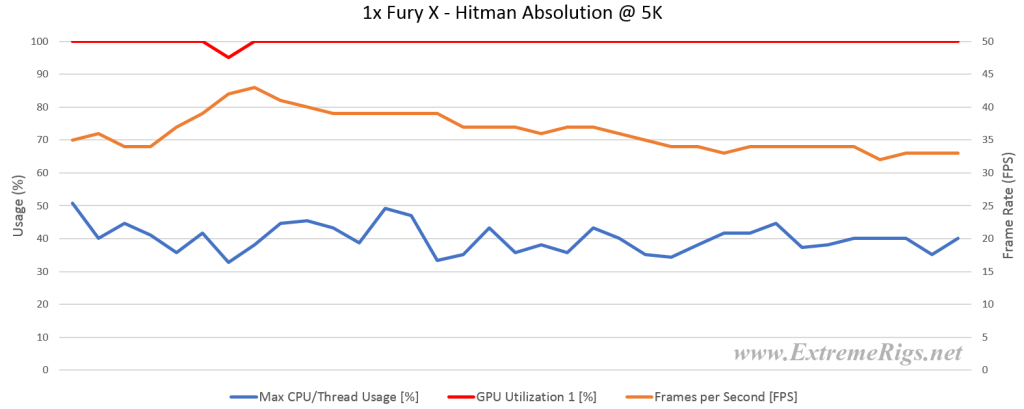
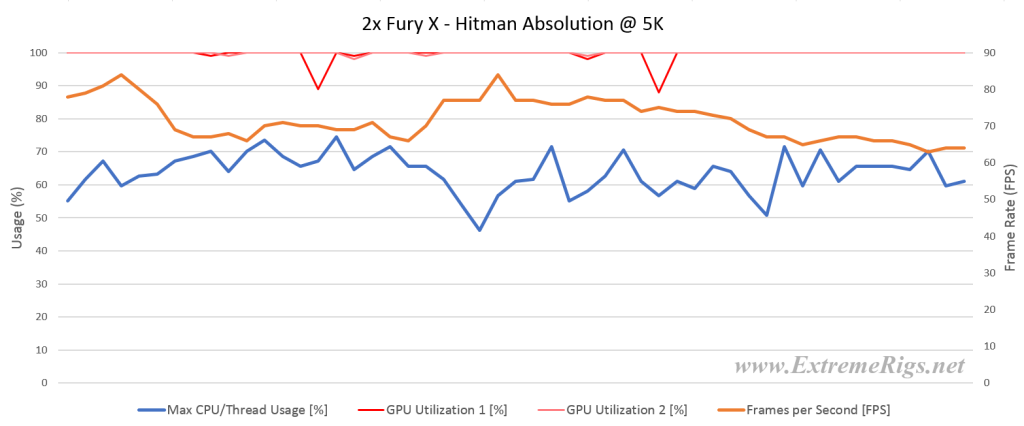
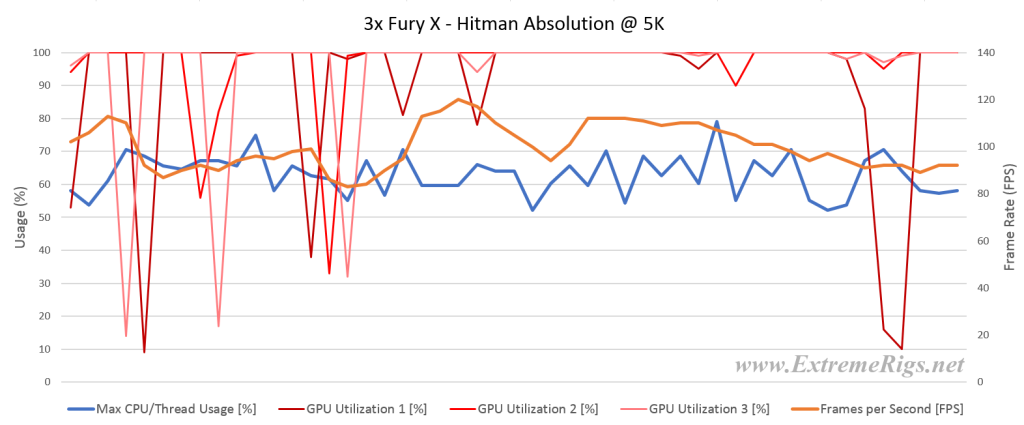 These are by far the cleanest usage plots we’ve seen for AMD. The larger usage spikes don’t happen until 3 way CFX and even then they aren’t affecting FPS. Let’s look at Nvidia:
These are by far the cleanest usage plots we’ve seen for AMD. The larger usage spikes don’t happen until 3 way CFX and even then they aren’t affecting FPS. Let’s look at Nvidia:
As usual things are very clean from Nvidia – however 2 way clearly shows how the GPUs are being under utilized. No wonder Nvidia generally has worse scaling.
Hitman Absolution is a very graphically intense game, but it’s important to note that during this benchmark MSAA was turned off and still 1-2 GPUs are really necessary to handle this game at 5k resolution. If you’re wanting to really max out this game you’ll need more than that!








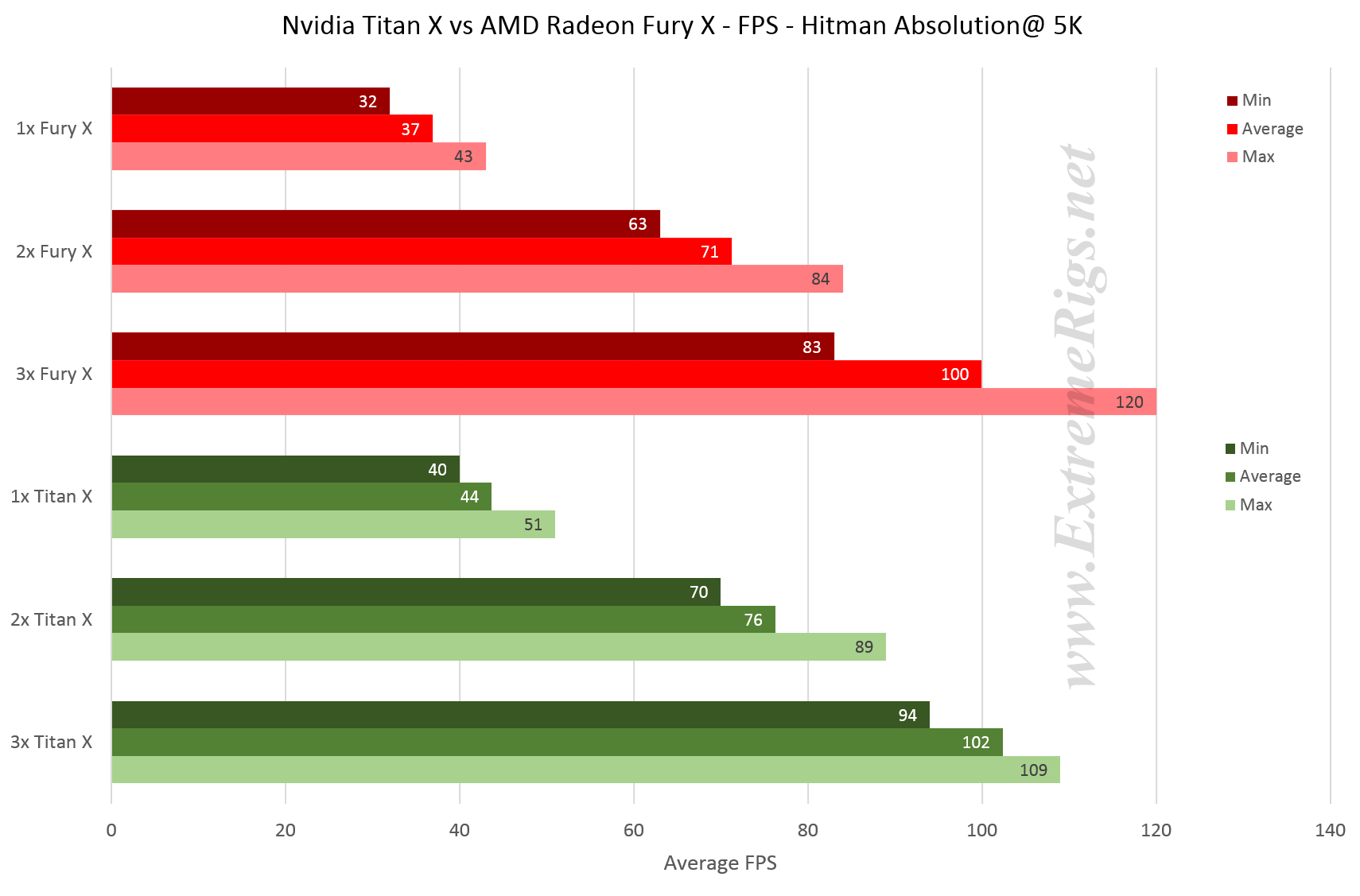
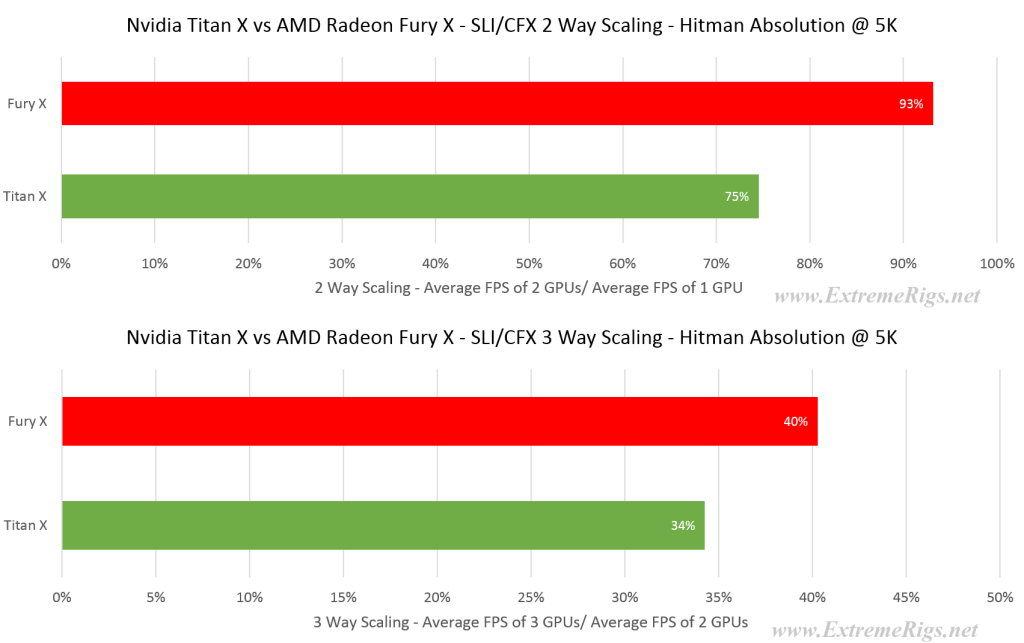
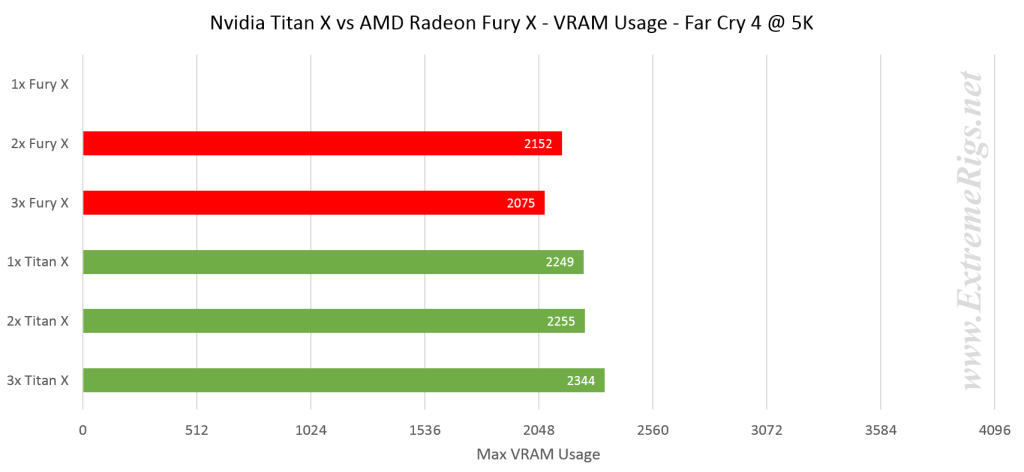
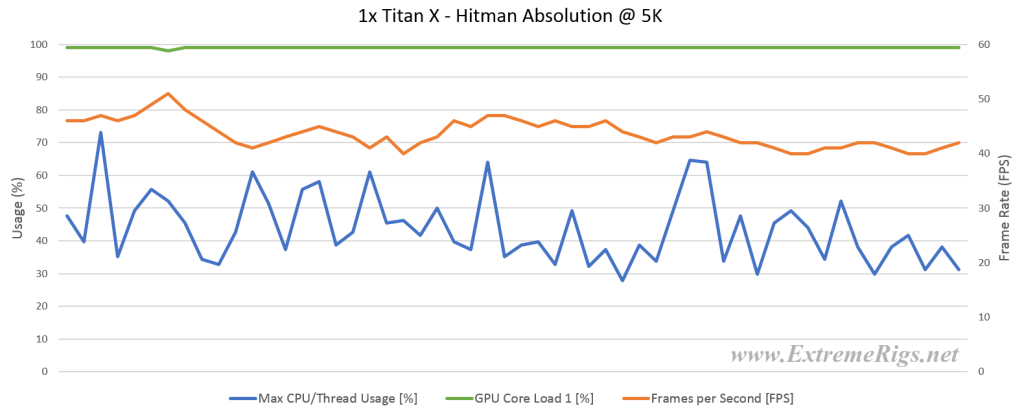
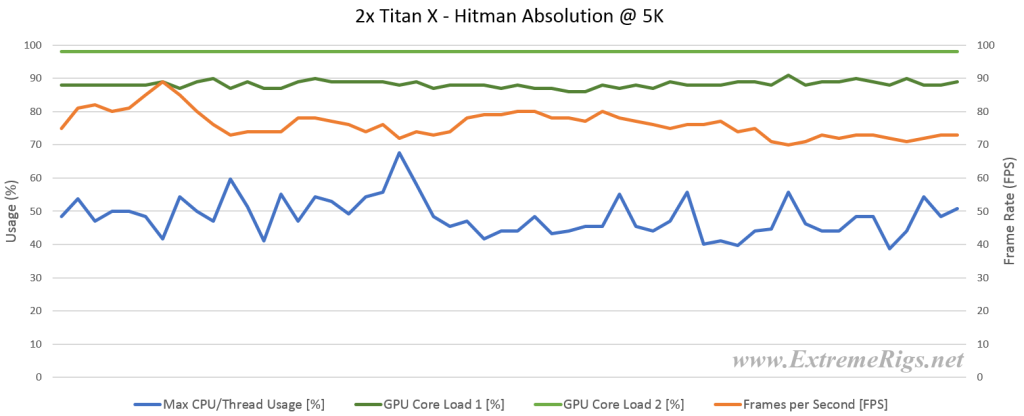
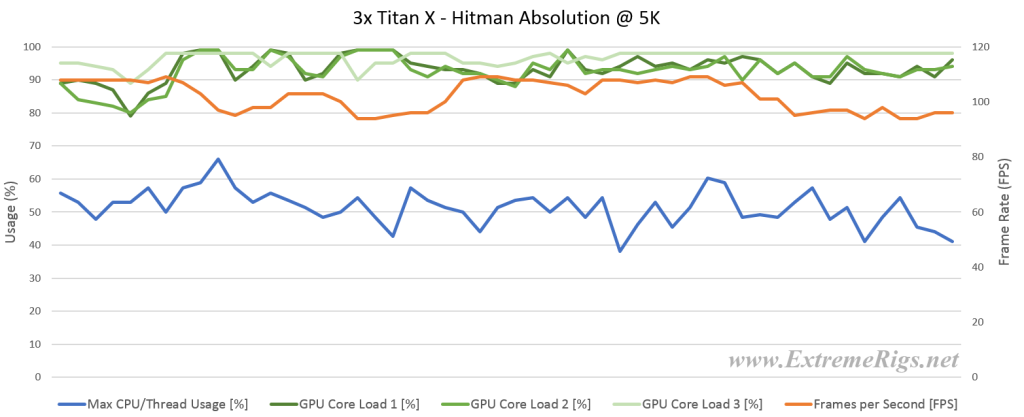



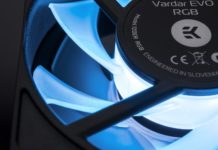

To be honest, I started reading this article with a thought that “well, how good can it be? ERs are watercooling guys so, nah! can’t expect too much”. But after reading the whole of it, I have to say, This is by far the one of the best comparative reviews I’ve ever seen, and really met all my expectations. Hats off to you guys!
Say, FuryX did have the claim in its pre-release rumor to be a TITAN X competitor, but then AMD shrunk that note to 980 Ti. So I think comparison with 980 Ti would’ve been better comparison (and seat clenching brawl) than this, and the clock-to-clock performance metrics but nonetheless, this is wayy too good also!
About capping the vRAM on FuryX in few games there, it also suffers from similar performance degradation on 4K and downwards. And as you may have seen on other reviews, FuryX does worse in sub-4K than the competition and even worse in 1080p. I’ve dug through every review out there yet haven’t found the reason behind this. What could be the reason?
And that scaling on nVidia – you know nvidia does claim that their SLI bridge isn’t a bottleneck, and so it is proved here :P. When AMD did introduce XDMA, I had this belief – AMD took the right path, bridges will suffer from less bandwith sooner or later, and PCIe already has the room for accommodating the data of the bridges. So XDMA did (well, now it is “do” :D) makes sense!
But it’s sad to see AMD not delivering smoother experience overall. If they could handle that thing, this should certainly deserved the choice over any of those higher average FPS of Titan X. But I think AMD is working on Win10 & DX12 optimized drivers and trying to mend it with bandages for now.
My only complain was the choice of TitanX over 980 Ti and clock-to-clock performance, but other than this, this is a very great review! Hats off to you again!
Agreed with Frozen Fractal. I was more than pleasantly surprised with the quality of this review, and I hope you continue to do these more in the future. A 980 Ti would have been nice to see too given the price.
Keep up the great work!
Thanks! I agree the 980 TI would have been a better comparison – then prices would have lined up. “Sadly” we only had Titan X’s and we weren’t willing to go out and buy another 3 GPUs to make that happen. However if anyone wants to send us some we’d gladly run em haha. I was simultaneously impressed with AMD’s results while saddened that after all the work on frame pacing that things still aren’t 100% yet. Hopefully
Question…you overclocked the Titan X to 1495MHz which is “ok” for a water cooling build. I won’t complain…though I’m surprised at why that’s all you were able to achieve as I can pull that off on Air right now (blocks won’t arrive until next week). Main question though…why wasn’t the memory overclocked? A watercooled Titan X has room to OC the memory by 20%, bumping up the bandwidth to 400Gbps, which brings it quite a bit closer to the 512Gbps of the HBM1 in the Fury X.
Although we didn’t mention it the memory was running a mild OC at 7.4Gbps up from the stock 7gbps
6gbps – so yes about the same as your 20% 🙂This is what concerns me about your understanding of overclocking. The Titan X memory is 7GHz at stock. At 7.4GHz you’re only running a 5.7% OC on the memory…
Hah you’re right, I was looking at titan stock memory settings not titan x. Yes it could have been pushed harder. Still though single Titan X was really good compared to Fury X – the issue it had was scaling. So unless scaling is significantly effected by memory bandwidth then I don’t think it changes the overall results much. When we re-run with overclocked furies we’ll spend a bit more time on the Titan X overclock too.
Don’t get me wrong…SLI scaling is definitely an issue and will still exist regardless. But you’d be surprised how important memory clocks can be depending on the test you’re running. I found this out when I was running the original GTX Titan Tri-Sli in the overclock.net unigine valley bench competition and came in second place. Leave the official redo for your next review of Fury X OC vs Titan X OC, as you mentioned. But to satisfy your own curiousity, try a higher memory clock and see what happens. If you were looking to squeeze out every last ounce out of your Titan X, you should check out http://overclocking.guide/nvidia-gtx-titan-x-volt-mod-pencil-vmod/ as well.
My Phobya nanogrease should be coming in tomorrow so I’ll finally be putting my blocks on as well. I’m going to compare my performance results with yours next time you run your benches. So make sure you do a good job. 😉
Excellent review. I am also running an Asus Rampage Extreme V with a 5960x OC’d to 4.4Ghz so your data really was telling. I’m running a single EVGA GTX980TI SC under water. I previously ran 2 Sapphire Tri-X OC R9 290s under water but opted to go with the single card.
Did you use a modded TitanX bios? What OCing tool did you use to OC the TitanX. I would like to try to replicate the parameters and run the single 980TI to see how close I am to your single TitanX data. Thank you.
Eh, i don’t really see the point of running AA in 5K 😛 Too bad it’s 5K btw, 4K is more reasonable. Too bad Fury X has problems with the Nvidia titles(W3 for example).
But man, the scaling and texture compression on amd cards are absolutely amazing. If only they weren’t bottlenecked by the HBM1’s 4GB of VRAM.
[…] Review: Titan X vs Fury X in a Triple CFX SLI Showdown […]
[…] Review: Titan X vs Fury X in a Triple CFX SLI Showdown […]
[…] Review: Titan X vs Fury X in a Triple CFX SLI Showdown […]
Comments are closed.